HTML
--> --> -->In heavy-ion collisions at intermediate energies, ranging from the Fermi energy to 100-200 MeV/nucleon, the isospin equilibration is always related to the production of fragments. The first attempt to study the isospin degree of freedom at the Fermi energy was reported in Ref. [33], where the reaction of
At intermediate energies, the fragmentation reaction is the main reaction mechanism, where a composite system splits into several fragments. Different theoretical transport models have been developed for describing the dynamics of fragmentation under certain approximations. One of these is the quantum molecular dynamics model (QMD) [54], in which the nucleon is considered a Gaussian wave packet with a finite width. Another is the semi-classical Boltzmann-Uehling-Uhlenbeck (BUU) model [55, 56], which has been extensively applied for describing one-body observables in nuclear collisions. However, the BUU model cannot be used for describing a fermion system's properties far from equilibrium, such as multi-fragmentation and subthreshold particle production [57-60]. The BUU model has been extended to consider the correlation effects between nucleons, using the Boltzmann-Langevin equation (BLE) [58-70]. It is well known that the BLE has been successfully used for describing fragmentation reactions [61, 62]. It incorporates a fluctuation into the collision term of the dynamical evolution of the system. By introducing the isospin effect into the BLE, we obtain the isospin-dependent Boltzmann-Langevin equation (IBLE). Another method that incorporates fluctuations into mean-field dynamics is the stochastic mean-field approach (SMF) [71, 72], and fragmentation characteristics have been analyzed using that approach [10, 73, 74]. A comprehensive comparison of these transport theories can facilitate future research, and many studies have been published on this subject. Xu and Zhang et al. compared different heavy-ion transport simulations under controlled conditions, including nine Boltzmann-Uehling-Uhlenbeck-type codes and nine quantum-molecular-dynamics-type codes [75, 76].
In this study, we determine our model's feasibility and then apply the IBLE model to investigate the isospin effects of projectile fragmentation in the mass-symmetric reactions including 58Fe, 58Ni + 58Fe, and 58Ni, at energies in the 30 to 100 MeV/nucleon range. The remainder of this paper is organized as follows. A brief introduction of the IBLE and the model test is given in Sec. II. The results and discussion are presented in Sec. III. Finally, conclusions are presented in Sec. IV.
$ \left(\frac{\partial}{\partial{t}}+\frac{{{p}}}{m} \cdot \bigtriangledown_{r}-\bigtriangledown_{r}U(\hat{f})\cdot\bigtriangledown_{p}\right) \hat{f}({{r}},{{p}},t) = K(\hat{f})+\delta K({{r}},{{p}},t). $  | (1) |
$ \begin{aligned}[b] K(\hat{f_{1}}) = &\int {\rm d}{{p}}_{2}{\rm d}{{p}}_{3}{\rm d}{{p}}_{4}W(12;34)\\ &[\hat{f_{3}}\hat{f_{4}}(1-\hat{f_{1}})(1-\hat{f_{2}})-\hat{f_{1}}\hat{f_{2}}(1-\hat{f_{3}})(1-\hat{f_{4}})], \end{aligned} $  | (2) |
$ W(12;34) = \frac{{\rm d}\sigma}{{\rm d}\Omega}\delta({{p}}_{1}+{{p}}_{2}-{{p}}_{3}-{{p}}_{4}) \delta(\epsilon_{1}+\epsilon_{2}-\epsilon_{3}-\epsilon_{4}), $  | (3) |
$ \langle{\delta K({{r}}_{1},{{p}}_{1},t_{1}) \delta K({{r}}_{2},{{p}}_{2},t_{2})}\rangle = C({{p}}_{1},{{p}}_{2})\delta({{r}}_{1}-{{r}}_{2}) \delta(t_{1}-t_{2}). $  | (4) |
$ \begin{aligned}[b] Q_{20} =& \int{{\rm d}{{r}}{\rm d}{{p}}\hat{Q}_{20}\hat{f}({{r}},{{p}},t)}\\ =& \int{{\rm d}{{r}}{\rm d}{{p}}(2{{p}}_{z}^{2}-{{p}}_{x}^{2}-{{p}}_{y}^{2})\hat{f}({{r}},{{p}},t)}, \end{aligned} $  | (5) |
$ \begin{aligned}[b] Q_{30} =& \int{{\rm d}{{r}}{\rm d}{{p}}\hat{Q}_{30}\hat{f}({{r}},{{p}},t)}\\ =& \int{{\rm d}{{r}}{\rm d}{{p}}({{p}}_{z}(2{{p}}_{z}^{2}-3{{p}}_{x}^{2}-3{{p}}_{y}^{2}))\hat{f}({{r}},{{p}},t)}.\end{aligned} $  | (6) |
In this model, the interaction nuclear potential, which includes the isospin degree of freedom for nucleons, is given as
$ \begin{aligned}[b] U_{\tau}(\rho,\delta,{{p}}) =& \alpha\frac{\rho}{\rho_{0}}+\beta\left(\frac{\rho}{\rho_{0}}\right)^{\gamma}+E_{\rm sym}^{\rm loc}(\rho)\delta^{2}\\ &+\frac{\partial E_{\rm sym}^{\rm loc}(\rho)}{\partial \rho}\rho\delta^{2}+E_{\rm sym}^{\rm loc}(\rho)\rho\frac{\partial\delta^{2}}{\partial\rho_{\tau}}+U_{\rm MDI}, \end{aligned} $  | (7) |
| EOS | α/MeV | β/MeV | γ | K/MeV |
| SM | ?390 | 320 | 1.14 | 200 |
| HM | ?130 | 59 | 2.09 | 380 |
Table1.Two sets of parameters adopted in IBLE.
$ E_{\rm sym}^{\rm loc}(\rho) = \frac{1}{2}C_{\rm sym}\left(\frac{\rho}{\rho_{0}}\right)^{\gamma_{s}}. $  | (8) |
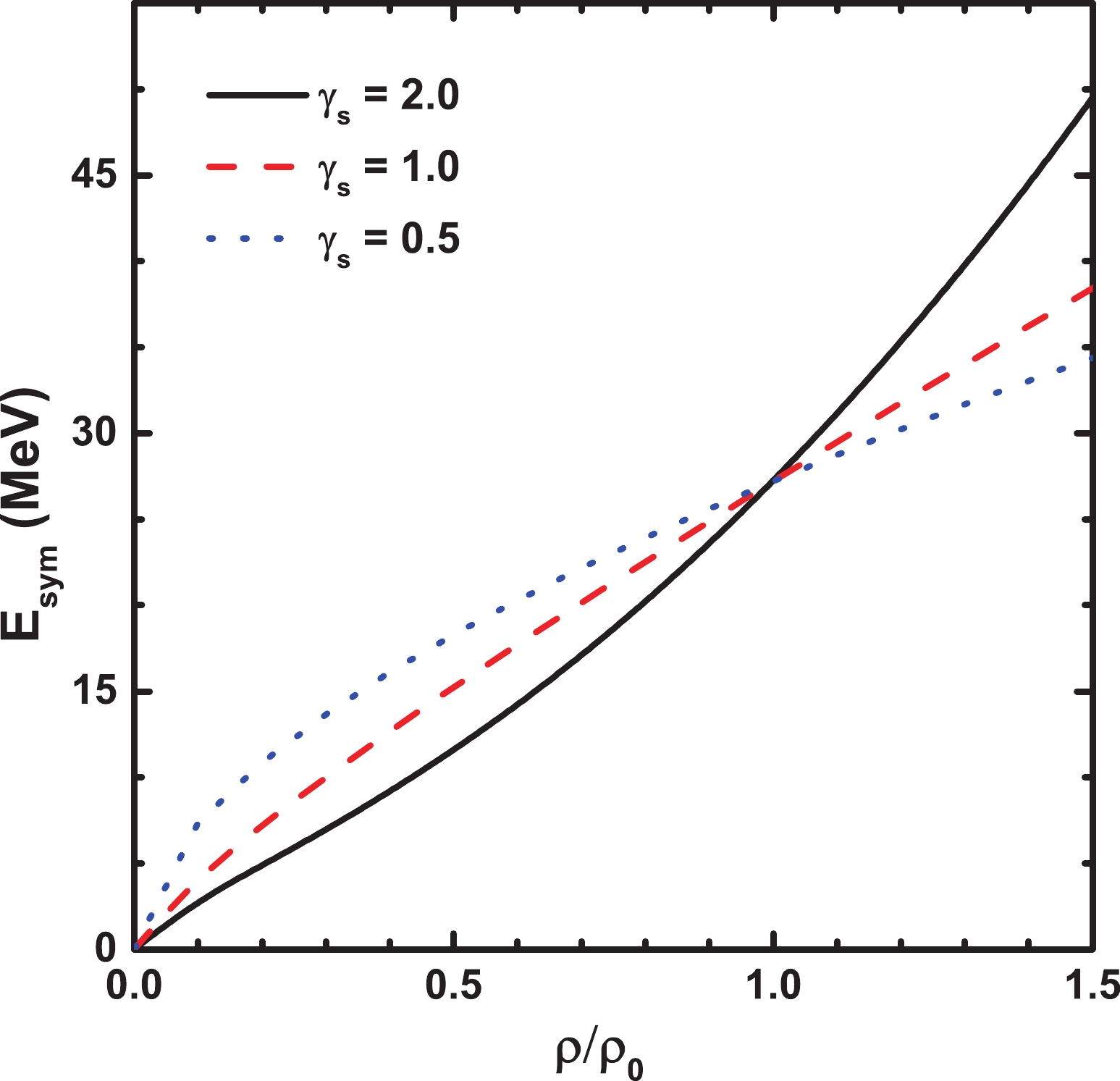 Figure1. (color online) Density dependence of the symmetry energy. The cases
Figure1. (color online) Density dependence of the symmetry energy. The cases The
$ U_{\rm MDI} = \frac{t_{4}}{\rho_{0}}\int\hat{f}({{r}},{{p}})[\ln(t_{5}({{p}}-{{p{'}}})^{2}+1)]^{2}{\rm d}{{p{'}}}, $  | (9) |
We construct clusters using the so-called coalescence model [62, 79-83], in which particles with relative momenta smaller than
We first test the IBLE model for describing the mass distributions of B element in the reaction of 40Ca+9Be at
As shown in Fig. 2, the black solid and blue dashed lines represent the IBLE and EPAX parametrization results, respectively. The red circles present the experimental data, which were taken from Ref. [87]. Clearly, the measured mass distribution is reasonably reproduced by the IBLE model. The most stable nuclides 10B and 11B yield the largest cross sections. For the 11B nuclide, we underestimate the cross section using the IBLE model, and the difference is within one order of magnitude. However, these results are consistent with the EPAX calculations, which also underestimate the cross section of the 11B nuclide. It is worth mentioning that our results indicate more neutron-deficient and neutron-rich nuclides, compared with the experimental data and EPAX parametrization results, because we simulate more events, which results in lower nuclide cross sections. Therefore, the IBLE model can be applied for calculating the cross sections and yields of fragments in projectile fragmentation reactions.
 Figure2. (color online) Mass distributions of B elements in the 40Ca+9Be reaction at 140 MeV/nucleon. IBLE calculations are shown as the black solid line. EPAX simulations are shown as the blue dashed line. Experimental fragmentation data are shown as red circles. The experimental data and EPAX calculations are taken from Ref. [87].
Figure2. (color online) Mass distributions of B elements in the 40Ca+9Be reaction at 140 MeV/nucleon. IBLE calculations are shown as the black solid line. EPAX simulations are shown as the blue dashed line. Experimental fragmentation data are shown as red circles. The experimental data and EPAX calculations are taken from Ref. [87].2
A.Symmetry energy dependence
To determine the effect of the symmetry energy on intermediate fragments, we begin our discussion by comparing the calculated yield ratios of the isobaric pairs of fragments for different symmetry energies with available experimental data. Figure 3 shows the mass distributions of Li and Be elements in the reactions of 58Ni+58Ni (N/Z = 1.07) and 58Fe+58Fe (N/Z = 1.23), which have a larger difference in N/Z, at 30 MeV/nucleon. In the reaction of 58Ni+58Ni, the isotope cross sections of Li and Be for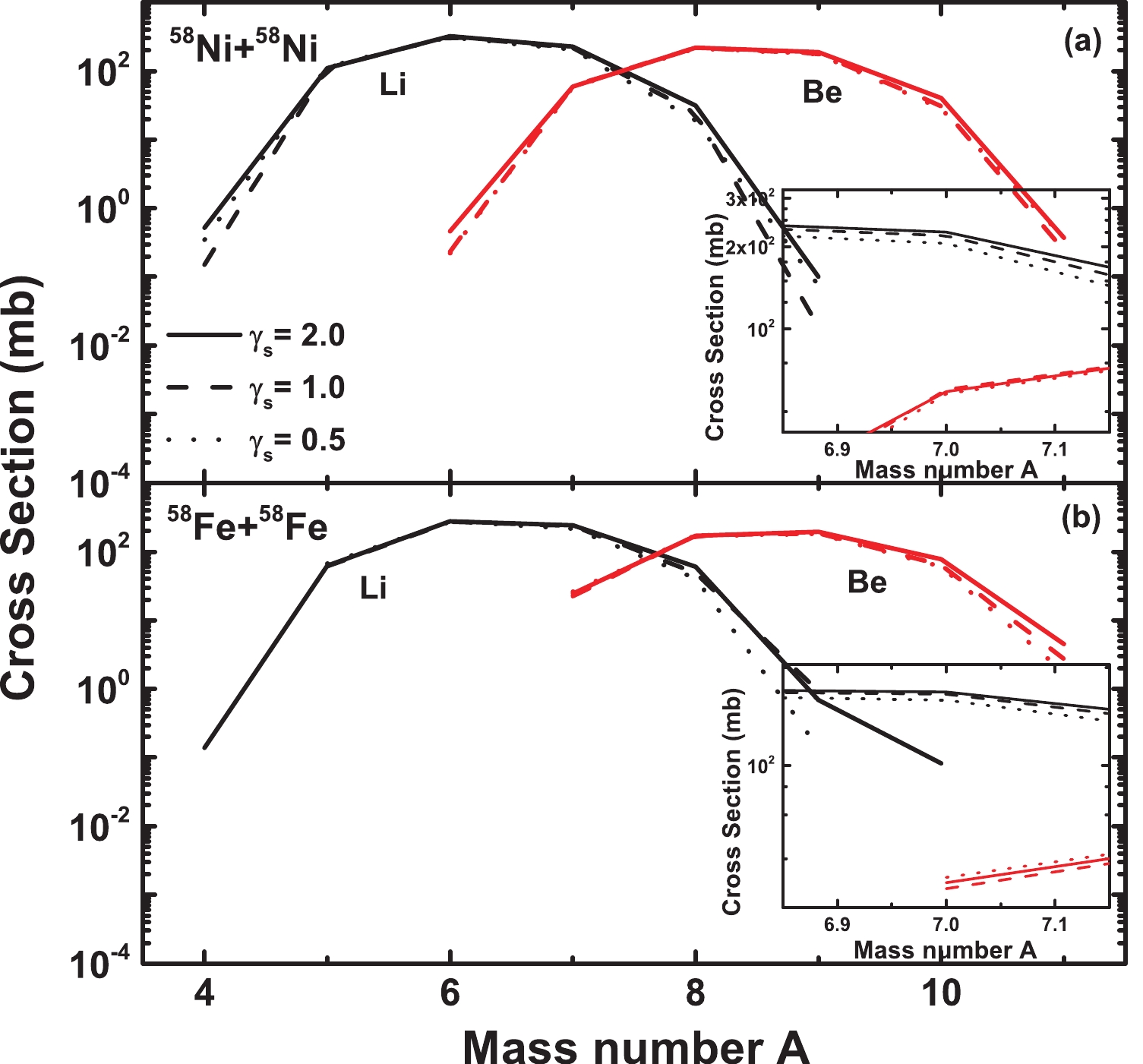 Figure3. (color online) Mass distributions for Li (black lines) and Be (red lines) elements in the reactions of 58Ni+58Ni (N/Z = 1.07) and 58Fe+58Fe (N/Z = 1.23) at 30 MeV/nucleon. The two insets show the magnifications around A = 7.
Figure3. (color online) Mass distributions for Li (black lines) and Be (red lines) elements in the reactions of 58Ni+58Ni (N/Z = 1.07) and 58Fe+58Fe (N/Z = 1.23) at 30 MeV/nucleon. The two insets show the magnifications around A = 7.Using the data in Table 2, we analyze the ratios as a function of the N/Z ratio of the composite systems, from more neutron-deficient 1.07 to more neutron-rich 1.23. Three symmetry energies are adopted, i.e.,
| system |   | Ycal | Yexp [86] | ||
  |   |   | |||
| 58Ni+58Ni | 1.07 | 3.814 | 3.632 | 3.535 | 2.992 |
| 58Ni+58Fe | 1.15 | 6.310 | 5.271 | 5.342 | 4.016 |
| 58Fe+58Ni | 1.15 | 6.330 | 5.583 | 5.169 | 4.272 |
| 58Fe+58Fe | 1.23 | 9.997 | 9.461 | 8.488 | 5.744 |
Table2.Yield ratios of the isobaric pair of fragments
The dependence of the yield ratio on the symmetry energy is obvious for the isobaric pair of fragments. In general, the distributions of the three symmetry energies are approximately the same. Stiffer symmetry energy leads to higher yield ratios for the isobaric pair of fragments. This phenomenon becomes more apparent in more neutron-rich systems, such as the 58Fe+58Fe reaction. At subnormal densities, as shown in Fig. 1, smaller
2
B.Incident energy dependence
We analyze the energy effect on the yield ratios of the isotopic, isobaric, and isotonic pairs of fragments, for different symmetry energies. Previous studies have shown that there is a transition from the isospin equilibrium at low energies to translucency at intermediate energies. This means that the isotopic, isobaric, and isotonic compositions of fragments will strongly depend on the N/Z ratios of the projectile and target but not much on the (N/Z)cs ratio of the composite system in the entrance channel [22, 33, 34, 50, 88-90]. We perform simulations for the four reactions at 30, 50, 70, and 100 MeV/nucleon from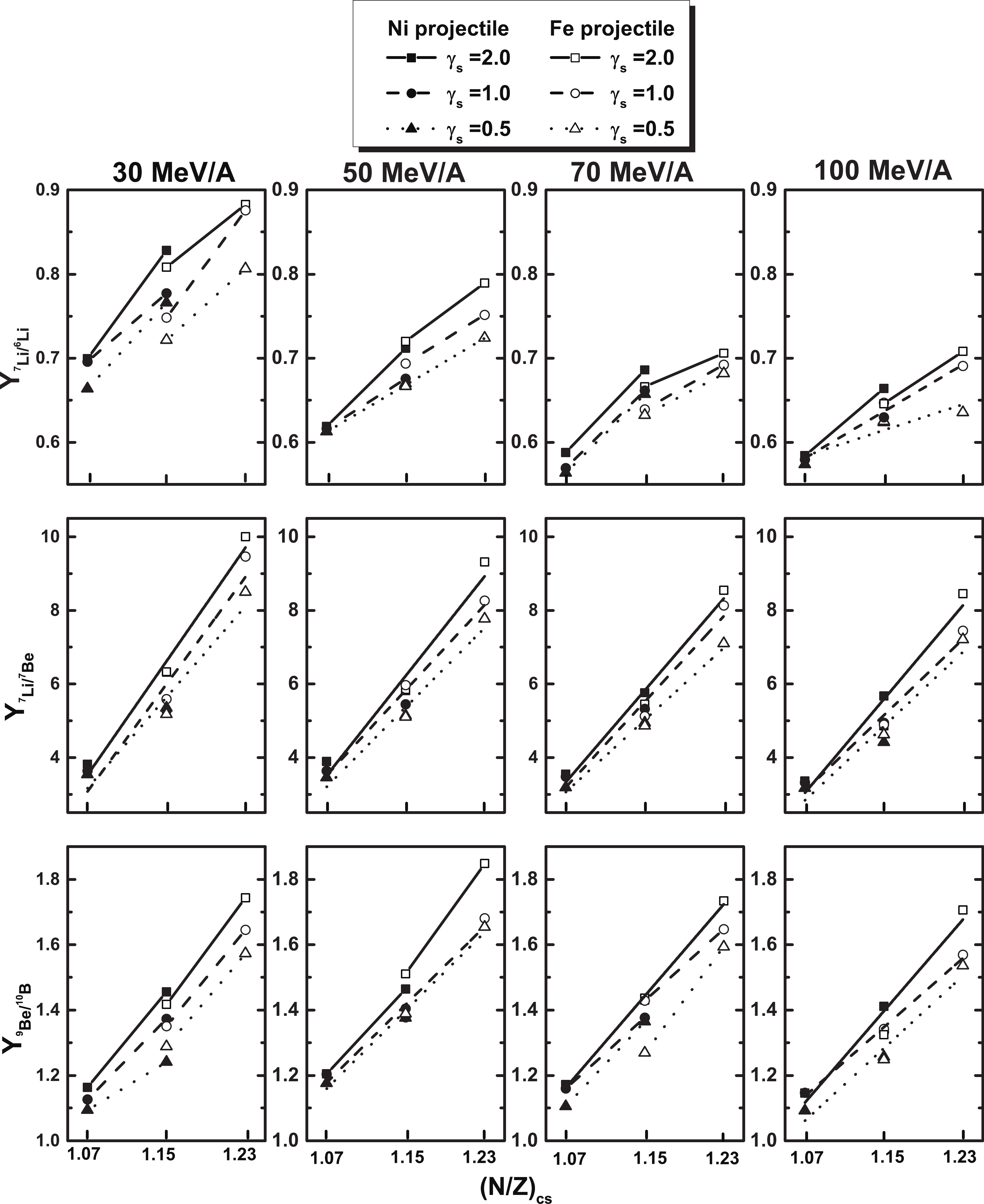 Figure4. Yield ratios of isotopic (upper row), isobaric (middle row), and isotonic (lower row) pairs of fragments from the four reactions at 30, 50, 70, and 100 MeV/nucleon, plotted as a function of the N/Z ratio of the composite system in the entrance channel. The four reactions are the same as in Table 2.
Figure4. Yield ratios of isotopic (upper row), isobaric (middle row), and isotonic (lower row) pairs of fragments from the four reactions at 30, 50, 70, and 100 MeV/nucleon, plotted as a function of the N/Z ratio of the composite system in the entrance channel. The four reactions are the same as in Table 2.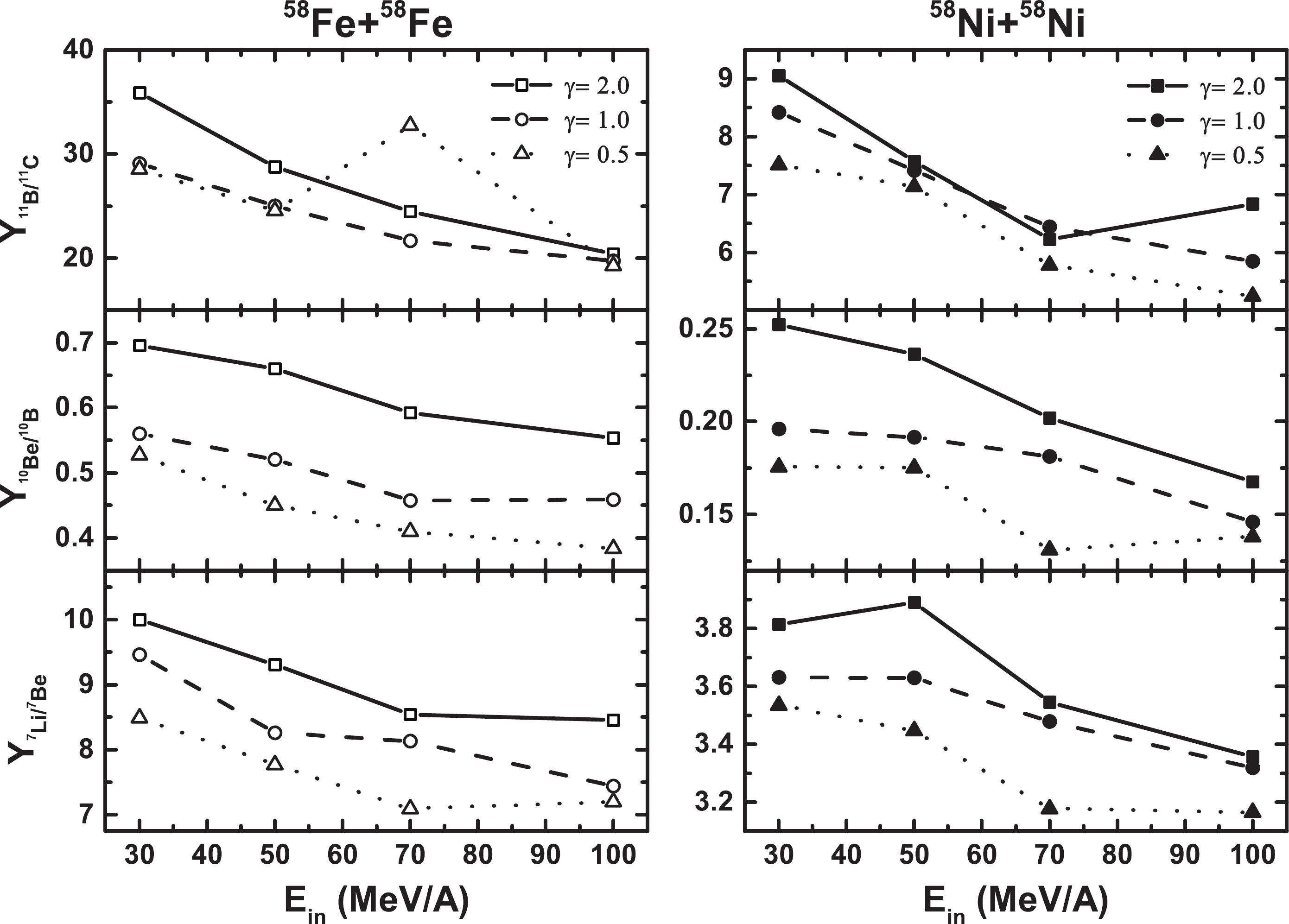 Figure6. The same as Fig. 5 but for the isobaric pair of fragments.
Figure6. The same as Fig. 5 but for the isobaric pair of fragments.From Fig. 4, it is obvious that as the energy increases, the isotopic (upper row), isobaric (middle row), and isotonic (lower row) yield ratios decrease, especially the isotopic and isobaric yield ratios. The descending trend is more moderate for higher incident energies, resulting in the closer yield ratios for the three symmetry energies at higher incident energies. This phenomenon indicates the weakening of the isospin effect with increasing energy, as nucleon-nucleon collisions become dominant at high energies. The yield ratios are functions of the N/Z ratio of the composite system in the entrance channel, but they do not all fall on a single line, as in Ref. [86]. As for the yield ratios of the isobaric pair of fragments, we report linear fits to these ratios because the symbols are too close to obtain the split. These results do not agree with previous data [88], where a split at an incident energy of 45 MeV/nucleon was reported experimentally, but none of the theoretical calculations reproduced the split. For the yield ratios of the isotopic and isotonic pairs of fragments, we observed some splits with three parameters of symmetry energies. The ratios for the reactions of Ni as a projectile do not overlap with that of Fe as a projectile, especially the ratios for the 58Fe+58Ni and 58Ni+58Fe reactions, which have the same N/Z ratios of the composite systems. These illustrate that intermediate mass fragment emissions depend not only on composite systems but also on the projectile and target nuclei. Moreover, the isospin degree of freedom does not reach equilibrium even at lower energies, which may be owing to the onset of nuclear transparency [89]. It is worth mentioning that this phenomenon of isospin nonequilibrium has also been discussed in Ref. [50].
Figures 5 and 6 present the yield ratios of the isotopic (Fig. 5) and isobaric (Fig. 6) pairs of fragments for the 58Fe+58Fe and 58Ni+58Ni reactions, plotted as a function of the incident energies in the 30 to 100 MeV/nucleon range. The yield ratios for the Ni+Ni reaction are lower than that for the Fe+Fe reaction, as the N/Z ratio of the composite system for the Fe+Fe reaction is relatively larger. This indicates that fragments are more neutron-rich in neutron-rich reaction systems. As the incident energy increases, the general trend of the yield ratio is to decrease but not sequentially. This phenomenon may be owing to the fact that the energy effect weakens for incident energies above 100 MeV/nucleon. It is worth noting that the yields of intermediate mass fragments in the projectile fragmentation change little for incident energies above 100 MeV/nucleon [87].
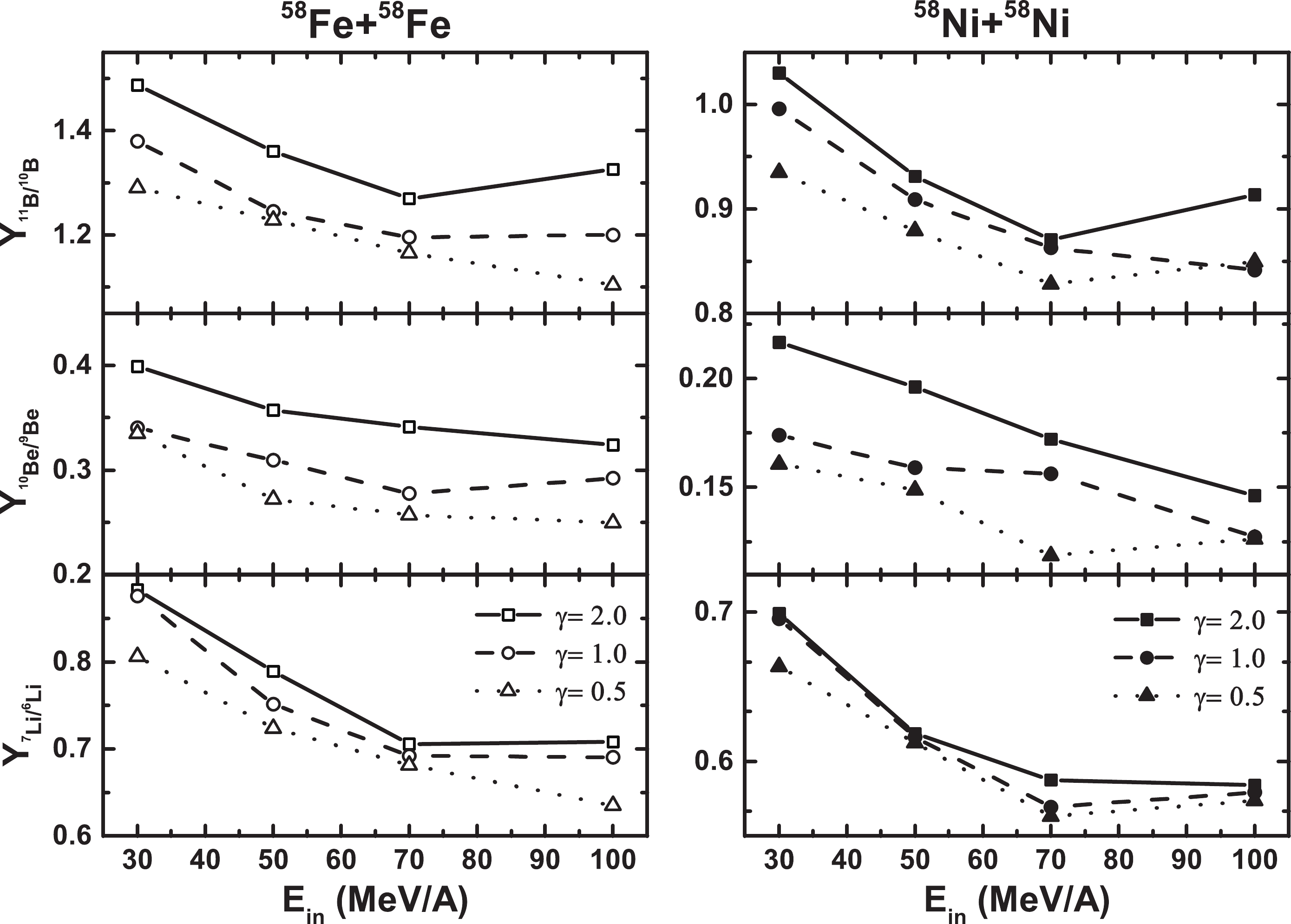 Figure5. Yield ratios for the isotopic pair of fragments, for the 58Fe+58Fe and 58Ni+58Ni reactions, plotted as a function of the incident energy in the 30 to 100 MeV/nucleon range.
Figure5. Yield ratios for the isotopic pair of fragments, for the 58Fe+58Fe and 58Ni+58Ni reactions, plotted as a function of the incident energy in the 30 to 100 MeV/nucleon range.In addition, in Fig. 5, the ratios of the isotopic pair of fragments for the symmetry energy parameter
